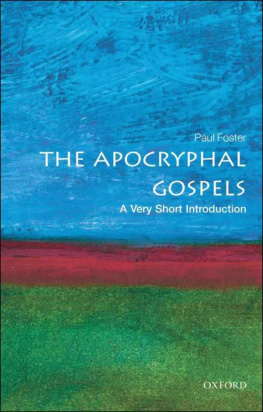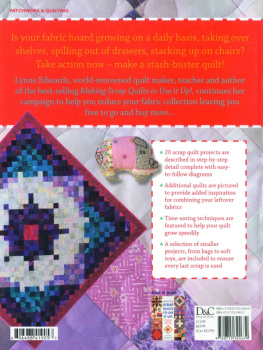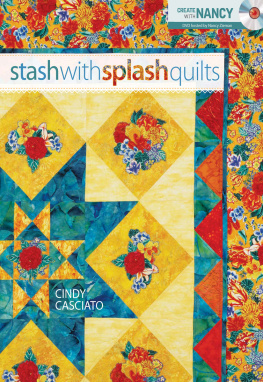Publisher: Amy Marson Creative Director: Gailen Runge Acquisitions Editor: Roxane Cerda Managing Editor: Liz Aneloski Editors: Monica Gyulai and Karla Menaugh Technical Editor: Linda Johnson Cover/Book Designer: April Mostek Production Coordinator: Zinnia Heinzmann Production Editor: Alice Mace Nakanishi Illustrator: Aliza Shalit Photography by Lucy Glover and Mai Yong Vang of C&T Publishing, Inc., unless otherwise noted Published by Stash Books, an imprint of C&T Publishing, Inc., P.O. Box 1456, Lafayette, CA 94549 dedication This book is dedicated to my husband, Alex. acknowledgments I would also like to acknowledge the East Midlands Modern Quilt Group in the UK, with special mention to Wendy Westby and Angela Lackey, who I miss very much.Thank you to the ladies I worked with at My Sewing Room in Calgary for their supportand shift swappingthroughout the writing process of this pattern pack: Anne, Barb, Betty, Dawn, Debra, Denise, Dixie, Doris, Gillian, Gwen, Jackie, Leatina, Nancy, Pat, Rebecca, Ruth, Sandy, and Sarah.Thank you also to the hugely talented Krista Hennebury, whose help kept me to deadline.To my sewing friends, past and presentGina Nickerson, Louise Phelps, and Cheryl Swabyand also my super-helpful developmental editors, Karla Menaugh and Monica Gyulai, who kept me on the right path, thank you.Many thanks to Tula Pink, Sulky, Aurifil, Trend-Tex Fabrics, Sew Me a Song, and Riley Blake Designs for supplying some of their great products, which I used while making the projects in this pattern pack. introduction In 2012, I sent my first-ever pictorial quilt to exhibit in Birminghams Festival of QuiltsEuropes largest quilt festival. I have continued to refine my techniques, and I share them with you in Paint-by-Number Quilts. My favorite part of the process is removing the freezer paper to reveal a juxtaposition of color, shade, and pattern. Usually I am pleasantly surprised. I have tried to reduce the risk and unpredictability of choosing fabrics by providing color keys for every project.
I love contemporary fabricsthe vast variety of solids and the endless designer collections that we can now cherry-pick from for our stashes. So many awesome blender fabrics can give a modern feel to pictorial quilts. Designers Alison Glass and Carolyn Friedlander are just two of my stash champions. Perhaps you will be inspired by these designs and create your own Paint-by-Number quilts using the same appliqu technique. Each of these projects started life as a photograph that I simplified by outlining the main shapes, highlights, and shadows. Then I enlarged them to quilt size.
I hope you will find making these as much fun as I do. Kerry Foster how to use this pattern pack Pictorial quilts can be put together more easily than you may think. This book is designed to make explorations into this form of quilting as easy as possible. Layout Guides Each project includes a black- and-white fabric-planning guide. You can color it in while planning a palette before starting a project or fill it in as you piece to keep track of your progress. Color Keys Color swatches are included with each project. Color Keys Color swatches are included with each project.
how to use this pattern pack Pictorial quilts can be put together more easily than you may think. This book is designed to make explorations into this form of quilting as easy as possible. Layout Guides Each project includes a black- and-white fabric-planning guide. You can color it in while planning a palette before starting a project or fill it in as you piece to keep track of your progress. Color Keys Color swatches are included with each project. Color Keys Color swatches are included with each project.
They extend to the edge of the page to make comparing fabrics to the hues easy. However, the colors dont need to be an exact match. The key is there to help you distinguish subtle differences in your stash, rather than to dictate fabric choices. For example, if a project has a gold and a yellow in it, the key will help you assess where you might place a mustard-colored fabric from your collection. Patterns A full-size pattern is given for each project (see pattern sheets P1P6). Scissors Its helpful to have three different types of scissors. Scissors Its helpful to have three different types of scissors.
The Tula Pink range offers good looks and great performance at a reasonable price point.  Micro-tip scissors and large shears by Tula Pink Large shears Shears are useful for general tasks, including cutting larger pieces of fabric into more manageable sizes and trimming piping cord, webbing, and fusible web. Micro-tip scissors These little guys get a lot of use with the prepared-edge appliqu method. Use them to snip around the curves of seam allowances, clip off points, trim small bits, and to get into tight spaces. Paper scissors Any scissors you have that are in good working order but that you dont use for fabric will fit the bill.
Micro-tip scissors and large shears by Tula Pink Large shears Shears are useful for general tasks, including cutting larger pieces of fabric into more manageable sizes and trimming piping cord, webbing, and fusible web. Micro-tip scissors These little guys get a lot of use with the prepared-edge appliqu method. Use them to snip around the curves of seam allowances, clip off points, trim small bits, and to get into tight spaces. Paper scissors Any scissors you have that are in good working order but that you dont use for fabric will fit the bill. 
 Glue Glue pens are great for appliqu work because they arent messy to use and the glue holds well.
Glue Glue pens are great for appliqu work because they arent messy to use and the glue holds well. 
 Glue Glue pens are great for appliqu work because they arent messy to use and the glue holds well.
Glue Glue pens are great for appliqu work because they arent messy to use and the glue holds well.
Unlike standard glue sticks, the glue pen moves more easily and more evenly over the weave of fabric, making it less likely that the fabric will pull away from the freezer paper. A few brands out there do a similar job, including Sewline and Fons & Porter. Get a pack of refills if you are working on a larger project. In a pinch, regular glue sticks will suffice, but are not as good.  Freezer Paper Freezer paper is available on a roll or as printer-ready sheets. The rolls are cheap and handy for fitting larger pattern pieces.
Freezer Paper Freezer paper is available on a roll or as printer-ready sheets. The rolls are cheap and handy for fitting larger pattern pieces.
But the printable paper-sized sheets allow you skip the step of tracing patterns by hand. They are a smart choice when photocopying patterns and can be taped together to accommodate larger designs. Thread There are a few different types of threads to use at different phases in the process of creating a Paint-by-Number quilt project.  Appliqu threads When stitching together the parts of an appliqu, you want the threads to be as invisible as possible. Monofilament threads are available in clear for light-colored fabrics and smoke for darks by various brands including Sulky.
Appliqu threads When stitching together the parts of an appliqu, you want the threads to be as invisible as possible. Monofilament threads are available in clear for light-colored fabrics and smoke for darks by various brands including Sulky.  Quilting threads Theres no hard and fast rule when it comes to choosing thread for quilting.
Quilting threads Theres no hard and fast rule when it comes to choosing thread for quilting.  Quilting threads Theres no hard and fast rule when it comes to choosing thread for quilting.
Quilting threads Theres no hard and fast rule when it comes to choosing thread for quilting.
Consider how visible you want your stitches, what colors are available, and whether you want some shimmer. For beginners, I recommend 40-weight thread (polyester or cotton) because its strong, which is helpful when sewing through the fabric layers that bulk up in joins. Bobbin thread For both piecing and quilting, I like to use a bobbin-specific thread. Polyester threads, such as DecoBob (by WonderFil Specialty Threads) and The Bottom Line (by Superior Threads), complement lightweight appliqu threads and reduce bulk when combined with thicker top threads. Perle cotton Keep some perle cotton #8 and hand sewing needles nearby for creating whiskers and other highlights.
Next page



















 how to use this pattern pack Pictorial quilts can be put together more easily than you may think. This book is designed to make explorations into this form of quilting as easy as possible. Layout Guides Each project includes a black- and-white fabric-planning guide. You can color it in while planning a palette before starting a project or fill it in as you piece to keep track of your progress. Color Keys Color swatches are included with each project. Color Keys Color swatches are included with each project.
how to use this pattern pack Pictorial quilts can be put together more easily than you may think. This book is designed to make explorations into this form of quilting as easy as possible. Layout Guides Each project includes a black- and-white fabric-planning guide. You can color it in while planning a palette before starting a project or fill it in as you piece to keep track of your progress. Color Keys Color swatches are included with each project. Color Keys Color swatches are included with each project. Micro-tip scissors and large shears by Tula Pink Large shears Shears are useful for general tasks, including cutting larger pieces of fabric into more manageable sizes and trimming piping cord, webbing, and fusible web. Micro-tip scissors These little guys get a lot of use with the prepared-edge appliqu method. Use them to snip around the curves of seam allowances, clip off points, trim small bits, and to get into tight spaces. Paper scissors Any scissors you have that are in good working order but that you dont use for fabric will fit the bill.
Micro-tip scissors and large shears by Tula Pink Large shears Shears are useful for general tasks, including cutting larger pieces of fabric into more manageable sizes and trimming piping cord, webbing, and fusible web. Micro-tip scissors These little guys get a lot of use with the prepared-edge appliqu method. Use them to snip around the curves of seam allowances, clip off points, trim small bits, and to get into tight spaces. Paper scissors Any scissors you have that are in good working order but that you dont use for fabric will fit the bill. 
 Glue Glue pens are great for appliqu work because they arent messy to use and the glue holds well.
Glue Glue pens are great for appliqu work because they arent messy to use and the glue holds well.  Freezer Paper Freezer paper is available on a roll or as printer-ready sheets. The rolls are cheap and handy for fitting larger pattern pieces.
Freezer Paper Freezer paper is available on a roll or as printer-ready sheets. The rolls are cheap and handy for fitting larger pattern pieces. Appliqu threads When stitching together the parts of an appliqu, you want the threads to be as invisible as possible. Monofilament threads are available in clear for light-colored fabrics and smoke for darks by various brands including Sulky.
Appliqu threads When stitching together the parts of an appliqu, you want the threads to be as invisible as possible. Monofilament threads are available in clear for light-colored fabrics and smoke for darks by various brands including Sulky.  Quilting threads Theres no hard and fast rule when it comes to choosing thread for quilting.
Quilting threads Theres no hard and fast rule when it comes to choosing thread for quilting.